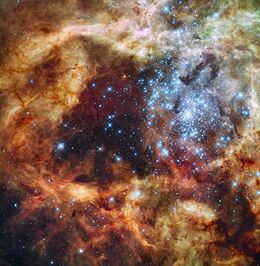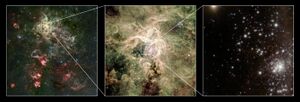Astronomy:Melnick 42
| Observation data Equinox J2000.0]] (ICRS) | |
|---|---|
| Constellation | Dorado |
| Right ascension | 05h 38m 42.12s[1] |
| Declination | −69° 05′ 55.19″[1] |
| Apparent magnitude (V) | 12.78[1] |
| Characteristics | |
| Spectral type | O2If*[2] |
| B−V color index | +0.08[3] |
| Astrometry | |
| Radial velocity (Rv) | 173[4] km/s |
| Distance | 163,000 ly (49,970[5] pc) |
| Absolute magnitude (MV) | −7.4[3] |
| Details | |
| Mass | 189[3] M☉ |
| Radius | 21.1[6] R☉ |
| Luminosity | 3,600,000[3] L☉ |
| Surface gravity (log g) | 3.90[7] cgs |
| Temperature | 47,300[3] K |
| Rotational velocity (v sin i) | 240[7] km/s |
| Age | ~1 million[8] years |
| Other designations | |
MK42, Brey 77, BAT99 105, 2MASS J05384212-6905552 | |
| Database references | |
| SIMBAD | data |
Melnick 42 is a massive blue supergiant star in the Tarantula Nebula in the Large Magellanic Cloud located in the constellation Dorado. Although it is only 21 times the size of the sun, its high temperature of 47,300 K makes it one of the most luminous stars of the Tarantula Nebula at 3,600,000 L☉. It is less than two parsecs from the centre of the R136 cluster, although that is well outside the central core.
Mk 42 was originally classified as spectral type WN when it was discovered, then as O3 If. When the slash stars were defined it was given the spectral type O3 If*/WN6. Finally, the introduction of the spectral class O2 and the refinement of slash star classifications led to it being tagged as O2 If*. Although it is given a supergiant luminosity class, it is effectively a main sequence star still burning hydrogen in its core. It is thought to be less than a million years old.[8]
See also
References
- ↑ 1.0 1.1 1.2 Doran, E. I.; Crowther, P. A.; De Koter, A.; Evans, C. J.; McEvoy, C.; Walborn, N. R.; Bastian, N.; Bestenlehner, J. M. et al. (2013). "The VLT-FLAMES Tarantula Survey. XI. A census of the hot luminous stars and their feedback in 30 Doradus". Astronomy & Astrophysics 558: A134. doi:10.1051/0004-6361/201321824. Bibcode: 2013A&A...558A.134D.
- ↑ Crowther, P. A.; Walborn, N. R. (2011). "Spectral classification of O2-3.5 If*/WN5-7 stars". Monthly Notices of the Royal Astronomical Society 416 (2): 1311. doi:10.1111/j.1365-2966.2011.19129.x. Bibcode: 2011MNRAS.416.1311C.
- ↑ 3.0 3.1 3.2 3.3 3.4 Bestenlehner, J. M.; Gräfener, G.; Vink, J. S.; Najarro, F.; De Koter, A.; Sana, H.; Evans, C. J.; Crowther, P. A. et al. (2014). "The VLT-FLAMES Tarantula Survey. XVII. Physical and wind properties of massive stars at the top of the main sequence". Astronomy & Astrophysics 570: A38. doi:10.1051/0004-6361/201423643. Bibcode: 2014A&A...570A..38B.
- ↑ Schnurr, O.; Moffat, A. F. J.; St-Louis, N.; Morrell, N. I.; Guerrero, M. A. (2008). "A spectroscopic survey of WNL stars in the Large Magellanic Cloud: General properties and binary status". Monthly Notices of the Royal Astronomical Society 389 (2): 806. doi:10.1111/j.1365-2966.2008.13584.x. Bibcode: 2008MNRAS.389..806S.
- ↑ Pietrzyński, G et al. (7 March 2013). "An eclipsing-binary distance to the Large Magellanic Cloud accurate to two per cent". Nature 495 (7439): 76–79. doi:10.1038/nature11878. PMID 23467166. Bibcode: 2013Natur.495...76P.
- ↑ Hainich, R.; Rühling, U.; Todt, H.; Oskinova, L. M.; Liermann, A.; Gräfener, G.; Foellmi, C.; Schnurr, O. et al. (2014). "The Wolf-Rayet stars in the Large Magellanic Cloud: A comprehensive analysis of the WN class". Astronomy & Astrophysics 565: A27. doi:10.1051/0004-6361/201322696. Bibcode: 2014A&A...565A..27H.
- ↑ 7.0 7.1 Puls, J.; Kudritzki, R.-P.; Herrero, A.; Pauldrach, A. W. A.; Haser, S. M.; Lennon, D. J.; Gabler, R.; Voels, S. A. et al. (1996). "O-star mass-loss and wind momentum rates in the Galaxy and the Magellanic Clouds Observations and theoretical predictions". Astronomy and Astrophysics 305: 171. Bibcode: 1996A&A...305..171P.
- ↑ 8.0 8.1 Crowther, P. A.; Schnurr, O.; Hirschi, R.; Yusof, N.; Parker, R. J.; Goodwin, S. P.; Kassim, H. A. (2010). "The R136 star cluster hosts several stars whose individual masses greatly exceed the accepted 150 M⊙ stellar mass limit". Monthly Notices of the Royal Astronomical Society 408 (2): 731. doi:10.1111/j.1365-2966.2010.17167.x. Bibcode: 2010MNRAS.408..731C.
 |



